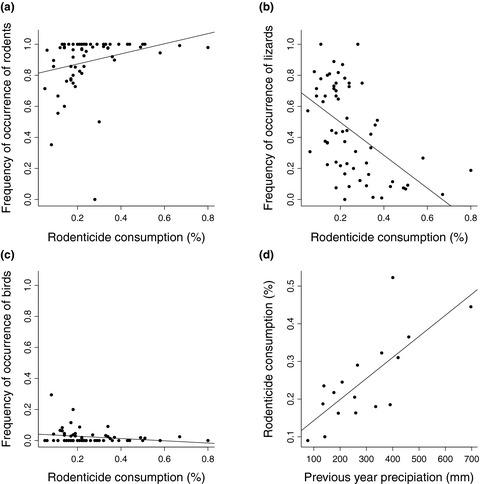当前位置:
X-MOL 学术
›
Anim. Conserv.
›
论文详情
Our official English website, www.x-mol.net, welcomes your
feedback! (Note: you will need to create a separate account there.)
Precipitation and prey abundance influence food habits of an invasive carnivore
Animal Conservation ( IF 2.8 ) Pub Date : 2019-04-24 , DOI: 10.1111/acv.12510 Mitchell A. Parsons 1 , Andrew S. Bridges 1 , Daniel S. Biteman 1 , David K. Garcelon 2
Animal Conservation ( IF 2.8 ) Pub Date : 2019-04-24 , DOI: 10.1111/acv.12510 Mitchell A. Parsons 1 , Andrew S. Bridges 1 , Daniel S. Biteman 1 , David K. Garcelon 2
Affiliation

|
Invasive predators threaten biodiversity worldwide, and generalist invasive predators are often more successful due to their broad diets. Predation patterns can be influenced by prey abundance, prey preference, and climate, and understanding these relationships is integral to conserving native prey species. We examined stomach contents of 2882 feral cats Felis catus from San Clemente Island, California, to assess how their diets varied annually and seasonally, and how precipitation and prey abundance influenced predation patterns. Rodents were found in 95% (n = 2589) of stomachs containing prey. The endemic San Clemente deer mouse Peromyscus maniculatus clementis was the most prevalent prey species and was found in 85% (n = 2589) of stomachs containing prey. Consumption of rodents, lizards, and birds varied annually. In years following dry winters, consumption of rodents decreased and consumption of lizards increased. This had a particularly strong effect on endemic night lizards Xantusia riversiana reticulata with 20.4% (n = 1952) of non‐empty cat stomachs containing night lizards following normal years, and 43.7% (n = 602) following dry years. Consumption of rodents peaked in fall, while consumption of lizards and birds peaked in spring. Using rodenticide removed from bait stations as an index of rodent abundance, we found a positive correlation between bait removal and the number of rodents consumed by cats, and a negative correlation between bait removal and the number of lizards consumed by cats. These results suggest that feral cats use rodents as primary prey and lizards as secondary prey, particularly during droughts when rodent abundance is low. Understanding how weather patterns affect invasive species predation patterns will help conservation biologists predict and manage for the effects of invasive species as climate change continues. Furthermore, identifying and quantifying diet pattern seasonality can help managers identify times when sensitive species are vulnerable and plan interventions accordingly.
中文翻译:

降水和猎物的丰富度会影响侵入性食肉动物的饮食习惯
侵略性掠食性动物威胁着世界范围内的生物多样性,而通才性侵略性掠食性动物由于其饮食结构广泛而通常更为成功。捕食方式可能会受到猎物数量,猎物偏好和气候的影响,并且了解这些关系对于保护本地猎物物种至关重要。我们检查了来自加利福尼亚圣克莱门特岛的2882只野猫Felis catus的胃内容物,以评估它们的饮食每年和季节性如何变化,以及降水和猎物的丰度如何影响捕食方式。在95%(n = 2589)的含有猎物的胃中发现了啮齿动物。地方性的San Clemente鹿鼠Peromyscus maniculatus clementis是最流行的猎物,发现的占85%(n = 2589)包含猎物的肚子。啮齿动物,蜥蜴和鸟类的消费每年变化。在干燥的冬季之后的几年中,啮齿动物的消费减少了,蜥蜴的消费增加了。这对地方性夜蜥蜴特别强的效果Xantusia riversiana网状与20.4%(Ñ = 以下正常年包含夜间蜥蜴非空猫肚子的1952),和43.7%(Ñ = 602)之后的干旱年份。啮齿动物的消费在秋季达到顶峰,而蜥蜴和鸟类的消费在春季达到顶峰。使用从诱饵站去除的灭鼠剂作为啮齿动物丰度的指标,我们发现诱饵去除率与猫所消耗的啮齿动物数量之间呈正相关,而诱饵去除率与猫所消耗的蜥蜴数量之间呈负相关。这些结果表明,野猫将啮齿动物用作主要猎物,将蜥蜴用作次要猎物,尤其是在干旱时,啮齿动物的丰度较低。了解天气模式如何影响入侵物种的捕食模式将有助于保护生物学家预测和管理随着气候变化的持续而对入侵物种的影响。此外,
更新日期:2019-04-24
中文翻译:

降水和猎物的丰富度会影响侵入性食肉动物的饮食习惯
侵略性掠食性动物威胁着世界范围内的生物多样性,而通才性侵略性掠食性动物由于其饮食结构广泛而通常更为成功。捕食方式可能会受到猎物数量,猎物偏好和气候的影响,并且了解这些关系对于保护本地猎物物种至关重要。我们检查了来自加利福尼亚圣克莱门特岛的2882只野猫Felis catus的胃内容物,以评估它们的饮食每年和季节性如何变化,以及降水和猎物的丰度如何影响捕食方式。在95%(n = 2589)的含有猎物的胃中发现了啮齿动物。地方性的San Clemente鹿鼠Peromyscus maniculatus clementis是最流行的猎物,发现的占85%(n = 2589)包含猎物的肚子。啮齿动物,蜥蜴和鸟类的消费每年变化。在干燥的冬季之后的几年中,啮齿动物的消费减少了,蜥蜴的消费增加了。这对地方性夜蜥蜴特别强的效果Xantusia riversiana网状与20.4%(Ñ = 以下正常年包含夜间蜥蜴非空猫肚子的1952),和43.7%(Ñ = 602)之后的干旱年份。啮齿动物的消费在秋季达到顶峰,而蜥蜴和鸟类的消费在春季达到顶峰。使用从诱饵站去除的灭鼠剂作为啮齿动物丰度的指标,我们发现诱饵去除率与猫所消耗的啮齿动物数量之间呈正相关,而诱饵去除率与猫所消耗的蜥蜴数量之间呈负相关。这些结果表明,野猫将啮齿动物用作主要猎物,将蜥蜴用作次要猎物,尤其是在干旱时,啮齿动物的丰度较低。了解天气模式如何影响入侵物种的捕食模式将有助于保护生物学家预测和管理随着气候变化的持续而对入侵物种的影响。此外,











































 京公网安备 11010802027423号
京公网安备 11010802027423号